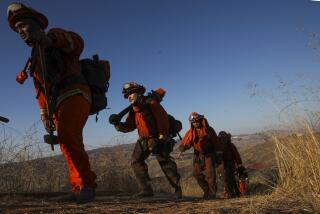Test Program Saves Heart Attack Victims : Medicine: System using firefighters, police and other emergency workers with minimal training could serve as model for other states, researchers say.
- Share via
A unique experiment in California involving the statewide use of heart defibrillators by firefighters, police officers and lifeguards with minimal training has saved nearly 200 heart attack victims while pioneering an emergency response system that other states can use as a model, experts in sudden cardiac death report.
All of the survivors were stricken in their homes, job sites or other places without medical facilities and were saved by the quick administration of electric shocks by so-called “first-responder personnel,” researchers reported in today’s Journal of the American Medical Assn.
The study involved 1,487 Californians who suffered cardiac arrest from 1987 through 1990 and received defibrillator shocks where they collapsed. Of the total, 1,009 were witnessed collapses, meaning that help was summoned quickly enough to give the patients a chance of survival. The survival rate was 19%, or 191 patients, according to the study, a rate that compares favorably to smaller research studies of the benefits of early defibrillation.
Daniel R. Smiley, acting director of the California Emergency Medical Systems Authority and a co-author of the JAMA article, said the study’s results provide impetus for placing automated defibrillators in the workplace, schools, sports venues and other places where employees could be trained to administer the lifesaving shocks before rescue squads arrive.
Defibrillators pass a high voltage current through the chest wall to correct a deadly heart rhythm disturbance called ventricular fibrillation. The devices have been recognized for years as critical tools in saving the lives of people who collapse from cardiac arrest.
But state regulations restricted their use to paramedics, leaving out emergency medical technicians and others who staff most police, fire and ambulance departments, or work as lifeguards at public pools and beaches.
In 1987, California’s Emergency Medical Services Authority expanded the regulations to include up to 300,000 police officers, firefighters and lifeguards in the pool of people who could be trained to use defibrillators. To date, 15,000 public safety personnel have had the training, up from 6,000 when only paramedics were authorized.
The eased restrictions largely were made possible by advances in defibrillator technology in the mid-1980s. Compared to the early defibrillators, which required expert medical analysts to operate them, today’s devices are computerized to do virtually all of the medical evaluation.
The machine will not administer a shock unless it records heart activity that could benefit from such a jolt. The operator attaches two wires to the stricken patient’s chest and presses a button that begins the machine’s analysis of the heart rhythm, according to Smiley. Training in the use of the automated defibrillators requires only four hours.
California partly based its action on the experience of Seattle’s renowned emergency medical response system, which demonstrated statistically in the mid-1980s that equipping first-response personnel with defibrillators improved survival rates. One in three adults in the city--compared to about one in six in most communities--is trained in the manual technique of forcing the heart to pump, called cardiopulmonary resuscitation.
But CPR is incapable of correcting ventricular fibrillation, which is responsible for about half the nearly 300,000 heart attack deaths each year in the United States. Equipping first-response personnel with defibrillators as opposed to limiting them to later-arriving paramedics greatly improved survival rates, Dr. W. Douglas Weaver, a leader of the Seattle program and an authority on early defibrillation, reported three years ago in the New England Journal of Medicine.
The California study took the Seattle experience several steps further, Weaver said. It implemented a statewide early defibrillation program that involved many local police, fire and rescue systems.
Defibrillation is only effective if the patient can be shocked within 6 to 10 minutes of collapse--a difficult task in some of California’s vast rural regions or traffic-choked urban centers such as Los Angeles.
Dr. Bruce E. Haynes, lead author of the JAMA study, said the 19% survival rate is a marked improvement over what was possible with delayed defibrillation or administration of defibrillation after the patient reached the hospital. In rural areas, where paramedics are scarce, survival rates for cardiac arrest range from 3% to 5%, Haynes said. Areas with paramedics who respond more than four minutes after the first responders have 50% fewer survivors than those whose first responders are equipped with defibrillators, he said.
“On a large-scale basis, these programs are going to save lives,” he said. Haynes was director of the California Emergency Medical Services Authority when the study began in 1987. He devised the data collection system that enables county and community early defibrillation programs to measure their success and the system the state uses to monitor overall results. He is an emergency medicine physician at Kaiser Permanente, San Diego Medical Center.
Equally significant contributions, Weaver said, are the legislation and regulations that enable California’s highly decentralized system to work. The four-hour training requirement, in addition to basic CPR training, is a statewide minimum for anyone using an automated defibrillator. But because of the devices’ cost, which ranges from $2,500 to $5,000, local emergency medical services authorities and public safety departments have only been able to train about 5% of the 300,000 eligible public safety personnel statewide.
More to Read
Sign up for Essential California
The most important California stories and recommendations in your inbox every morning.
You may occasionally receive promotional content from the Los Angeles Times.













